Celebrating the cultural impact of pantomime in Scotland
Submitting Institution
University of GlasgowUnit of Assessment
Communication, Cultural and Media Studies, Library and Information Management Summary Impact Type
CulturalResearch Subject Area(s)
Studies In Human Society: Policy and Administration
History and Archaeology: Historical Studies
Summary of the impact
The Pantomime in Scotland touring exhibition attracted audiences of
63,000 people between 2008
and 2010. It was supported by a national programme of community events for
schools and the
general public, gathering memories from older visitors to form part of an
ongoing cultural archive.
The discovery and re-recording of film and music from the 1930s-50s led to
two concerts attended
by 700 people in 2010, and the creation of a DVD, which has sold 500
copies since its production
in 2009. Publicity surrounding the exhibition and related events reached
an estimated circulation of
467,330 across print media and audiences of over 1 million across Scottish
radio and television.
Underpinning research
Building on research already undertaken by Adrienne Scullion (from 1996
lecturer, senior lecturer,
then Chair in Drama at the University of Glasgow [UoG]) and Paul Maloney
(PDRA at UoG, 2007-11)
into Scottish popular theatre, touring theatre, children's theatre and
theatre in rural areas,
Pantomime in Scotland was an Arts and Humanities Research
Council-funded research project
(2007-10) based in UoG's School of Culture and Creative Arts. The aim of
this unique project was
to explore, document and celebrate one of Scotland's great popular art
forms. The research project
demonstrated that pantomime in Scotland is culturally and economically
significant — contributing
14% of total revenue in Scottish theatre in 2008-9 — and a distinctive
part of cultural life and
expression, highly valued by audiences and professionals alike.
Scullion and Maloney's previous research focused on the particular
significance of popular
forms of theatre in Scotland. With reference to distinctive performance
traditions and industrial
arrangements and infrastructure, the researchers had noted the seemingly
privileged place of
pantomime within Scotland's wider culture of professional and
non-professional theatre-making, in
both urban and rural contexts.
The new research project investigated pantomime in Scotland at a critical
juncture: recording
the memories of the generation who experienced the inter-war heyday of
Scottish pantomime; and,
analysing this popular theatre phenomenon while it continued as a
functioning commercial form.
Led by Scullion, the project investigated both the history and
contemporary manifestations of
professional (subsidised and commercial) pantomime as well as community
and non-professional
pantomime in both urban and rural areas. With reference to key critical
tropes of popular culture
and theatre, gender, local/regional appeal, diaspora and national profile,
the project examined
pantomime images, representations and identities; memories, recollections
and histories;
economics, industry and infrastructure.
A major discovery for the project was a previously unknown private
collection of musical scores
and band parts written for pantomimes in Glasgow between the 1920s and
1940s. In collaboration
with Scottish Opera, Linn Records, Glasgow Life, freelance musicians,
musical directors and
producers these scores were reset and the music was realised, recorded and
performed for new
audiences.
Datasets — oral history
The team created qualitative and quantitative datasets, with the former
including a national oral
history programme. Involving audience members and practitioners, oral
history research captured
the collective experience of pantomime in Scotland across all its aspects,
from memories of the
large-scale professional spectaculars of the inter-war years to those of
school and community
productions today. The oral history project and programme of interviews
captured memories from
all age groups, with a particular focus on the generation that grew up in
the 1920s and 1930s.
Their recollections of the experience of popular theatre-making and
theatre-going in the inter-war
period constitute a unique resource for future theatre historians and
popular culture researchers.
Datasets — economic analysis
A second strand of data capture was a national pantomime census and
economic impact study
capturing information about both commercial and non-professional
pantomimes across Scotland in
the pantomime season of 2008-9. Working with the Fraser of Allander
Institute at the University of
Strathclyde — who provided the economic modelling package — the UoG
researchers undertook a
national survey of all professional and amateur pantomime activity in
2008-9. The researchers
established the economic significance of pantomime, showing that 9% of the
population in
Scotland attended a professional pantomime in 2008-9 and 31% saw or were
involved in making a
non-professional pantomime. The 21 professional pantomimes that formed the
survey generated
total receipts of £5.7 million, supported 291 jobs (132 directly, 291
indirectly), and generated a total
of £3.46 million wages in Scotland. Pantomime represents 14% of total
theatre revenue in
Scotland. These new datasets constitute major new resources of wider
relevance to researchers of
popular culture, social history, community arts and to industry
practitioners and policy-makers:
providing a new data set and reference point for Fraser of Allander's
ongoing analysis of the
Scottish economy and its industries; and, serving as a tool for theatre
producers — eg, Ambassador
Theatre Group at the King's Theatre Glasgow used the information as part
of its successful
Heritage Lottery Fund application in 2011.
References to the research
Publications — all available from the HEI:
— Paul Maloney, `Twentieth-century popular theatre', Edinburgh
Companion to Scottish Drama,
ed. Ian Brown (Edinburgh: Edinburgh University Press, 2011), pp. 60-72.
ISBN9780748641079.
— Paul Maloney, `Wha's like us?: ethnic representation in music
hall and popular theatre and the
remaking of urban Scottish society', From Tartan to Tartanry:
Scottish Culture, History and
Myth, ed. Ian Brown (Edinburgh: Edinburgh University Press, 2010),
pp.129-50.
ISBN9780748638772.
— Paul Maloney, `Flying down the Saltmarket: the Irish on the
Glasgow music hall stage',
Nineteenth Century Theatre and Film 36.1 (2009), pp. 11-36.
Peer-reviewed. ISSN1748-3727.
— Adrienne Scullion, `Theatre work in Scotland', Working Life
of the Scots: Craft and Service, eds
Mark Mulhern, John Beech and Elaine Thompson, volume 7 (of 14) in the
series Scottish Life
and Society: A Compendium of Scottish Ethnology (Edinburgh: Tuckwell
Press / National
Museums of Scotland / European Ethnological Research Centre, 2008), pp.
369-84.
ISBN9781904607854.
— Adrienne Scullion, The Same, But Different: Rural Arts
Touring in Scotland (Stroud: Comedia,
2004). ISBN1873667876.
— Paul Maloney, Scotland and the Music Hall, 1850-1914
(Manchester: Manchester University
Press, 2003). ISBN9780719061462.
Grants:
— AHRC — Research Grant (Pantomime in Scotland, 2007; value
£532,450)
— National Library of Scotland — Grants (Pantomime in Scotland,
2009, 2010; value £3,600)
Details of the impact
Pantomime has a long history in Scottish communities, with nearly a third
of all people in Scotland
in 2008-9 either attending a pantomime or taking part in an amateur or
professional production.
Pantomime is notable for its family and community spirit, with local
in-jokes and scripts, inclusive
spirit, and enduring popularity throughout the rise of digital and global
entertainments. Scullion and
Maloney's research project Pantomime in Scotland formed the basis
of a nationally touring
exhibition which ran over the winters of 2008-9 and 2009-10. Curated by
Scullion, the exhibition
was accompanied by a series of community events for schoolchildren,
families, elderly people and
the general public. This reflected the project's central aim of promoting
a wider public appreciation
of pantomime's contribution to Scottish culture. In addition to the
interactive multimedia touring
exhibition, materials collected over the course of the research, including
the newly discovered
archive of pantomime musical scores from the 1920s-40s, were produced on
DVD with a
companion booklet. The cultural archive was extended and developed with
the recollections of
members of the public gathered from those attending the exhibition or
related events. The
exhibition and related work attracted Scotland-wide media interest and
tapped into the community
spirit at the heart of pantomime, creating and interpreting cultural
capital and enriching the lives of
individuals and groups.
National touring exhibition
The Pantomime in Scotland exhibition covered pantomime's Victorian
origins up to the present
day, with memorabilia, audio recordings from the research survey of folk
memories of particular
shows, and archive film footage from the National Library of Scotland and
Scottish Screen of
shows from the 1930s-50s. The exhibition toured major theatres across
Scotland in pantomime
seasons 2008-9 and 2009-10, and was attended by over 63,000 members of the
public at venues
in the east and north of Scotland in 2008-9 (the King's Theatre Edinburgh,
Perth Theatre, Byre
Theatre St Andrews, His Majesty's Theatre Aberdeen and Eden Court Theatre
Inverness) and at
venues in the west of Scotland in 2009-10 (Motherwell Theatre, King's
Theatre Glasgow and the
MacRobert Centre Stirling). It generated significant national media
coverage, reaching an
estimated print circulation of 467,330 and well over 1 million
listeners/viewers on radio and
television. The exhibition was flagged as a cultural `Highlight of the
week' by The Herald (17
November 2009) and it also featured in The Scotsman (3 December
2008), The Press and Journal
(15 January 2009), The Sunday Post, The Perthshire Advertiser
(3 December 2009) and in The
Big Issue and Scottish Memories magazine, in addition to
radio shows on BBC Radio Scotland — the
news programme Good Morning Scotland and magazine programme MacAulay
and Co — and
BBC Radio Five Live and Real Radio. It featured on the BBC Scotland's news
bulletins, including
its main programme Reporting Scotland (26 November 2008) and on
STV News (4 December
2009 and on 24 June 2010) and on the STV magazine programme The Hour
(11 December 2010).
The exhibition — at
King's Theatre,
Glasgow, right — provided an
opportunity for the
public to learn about
the history and roots
of contemporary
pantomime, thereby
adding value to their
experience and understanding.
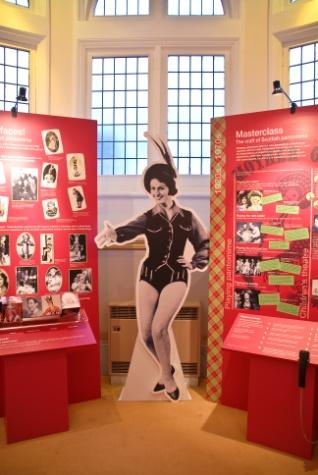
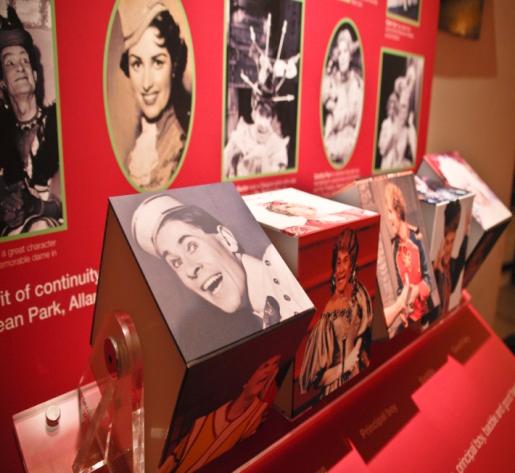
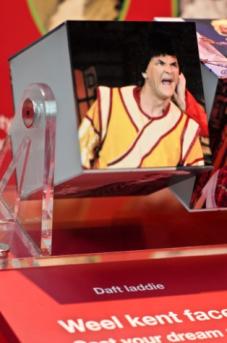
Outreach events for schools and community groups
A programme of free education and outreach events accompanied the
exhibition tour, including:
talks for the general public — eg, `Parliamo Panto', a roundtable
discussion with pantomime
performers at the King's Theatre, Glasgow; drama and art workshops for
schools and for families — eg,
`Pantomime puppets' at the MacRobert Arts Centre in Stirling and the Eden
Court Theatre in
Inverness; and, film screenings at the National Library of Scotland and
the Byre Theatre in St
Andrews for the general public and community groups. Reminiscence events —
eg, at the King's
Theatre Edinburgh and His Majesty's Theatre, Aberdeen — encouraged
visitors to share their
memories and experiences of participating in or attending pantomime,
enabling the creation of the
memories archive. These events attracted total audiences of around 800.
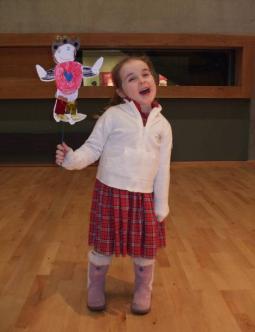
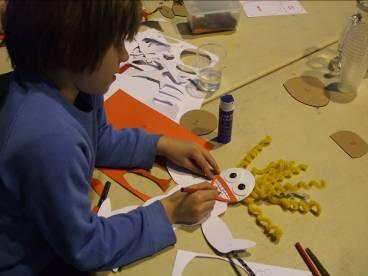
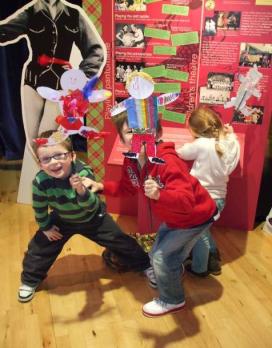 Pantomime puppets workshops Eden Court Theatre Inverness
Pantomime puppets workshops Eden Court Theatre Inverness
Creating an archive of Scottish pantomime on film
In 2009, the research team (in collaboration with Scottish Opera and
Glasgow Life) produced a
DVD and booklet of archived silent films from the 1930s, 1940s and 1950s
with a soundtrack
featuring the newly discovered contemporary pantomime music. Pantomime
in Scotland: a
celebration of Scottish pantomime on film was produced by
UoG/National Library of Scotland-Scottish
Screen Archive, and was narrated by pantomime star Stanley Baxter. The DVD
also
includes a rare sound film featuring Scottish variety performer Tommy
Lorne and an equally rare
film advertisement for a winter variety show in Glasgow, promoted as a
seasonal alternative to
pantomime. The DVD has sold 500 copies since its release in 2009.
Further events and talks focused on the archive film and were delivered
at: the Glasgow Film
Theatre (GFT) — two events including one as part of its `Silver Screen'
programme targeting older
audiences, the MacRobert Arts Centre in Stirling, Perth Concert Hall, His
Majesty's Theatre
Aberdeen and Motherwell Civic Theatre attracted audiences of 450 people.
These events were all
devised by the UoG researchers and delivered in partnership with the
venues as part of their winter
schedules. These public events were generally introduced by Scullion, with
presentations by
Maloney and the then Education Officer for the Scottish Screen Archive) on
the history of Scottish
pantomime and technical aspects of the films. At the GFT an events
musician Karen MacIver
played live improvised piano scores.
In 2010 Glasgow Life, Glasgow UNESCO City of Music and the National
Library of Scotland
responded positively to approaches from the UoG researchers to present two
concert screenings
of music created for the DVD with the Orchestra of Scottish Opera. Hosted
by pantomime star
Elaine C Smith, 700 people attended the events, the audience demographic
significantly older than
the families and schools targeted by the exhibition's main impact
activities, thus extending the
public benefit of the project.
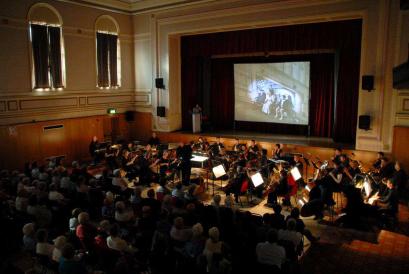

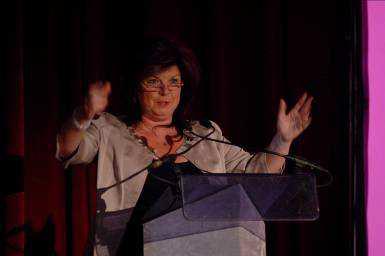 Pantomime on film Woodside Hall Glasgow
Pantomime on film Woodside Hall Glasgow
Sources to corroborate the impact
Materials generated by the UoG project team — available from the
HEI:
— Promotional materials generated by the UoG team to support and promote
the project — detailing
the public-facing activities by year and by event.
— Feedback and evaluations of Pantomime in Scotland events.
Testimonial confirming value of project as enhancing holdings of
Scottish Screen Archive
by way of identification of content and its digitisation and promotion
in range of public-facing
contexts — ie, creating and interpretation of cultural capital —
available from the HEI:
— Testimonial from Manager, Scottish Screen Archive.
Selection of testimonials from project partners, confirming that the
exhibition and public-
facing events added value to audiences' experiences and drew in more
audiences to
venues/events — ie, enriching and expanding lives — available from
the HEI:
— Testimonial from Marketing Manager, Ambassador Theatre Group (King's
Theatre and Theatre
Royal, Glasgow)
— Testimonial from Divisional Head of Marketing, Ambassador Theatre Group
(North)
— Testimonial Director of Policy and Research, Glasgow Life
— Testimonial from Commercial Director, Festival City Theatres Trust
(Edinburgh)
Selection of press coverage evidencing raised profile and popularity
of pantomime events:
— New
exhibit celebrates pantomime (BBC News, 26 November 2008); Pantomime
in Scotland
(The List, 19 November 2009); New
panto exhibition is on...oh yes it is! (Perthshire Advertiser,
3
December 2009); Scotland's
other national theatre (Press and Journal, 15 January 2009);
Early
Scottish
panto stars are brought to life (oh yes they are) (The Scotsman,
3 December 2008); Oh
yes
it is ... new tribute to Scots panto culture (The Herald, 17
November 2009; STV
News (4
December 2009).